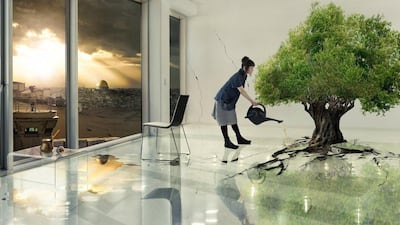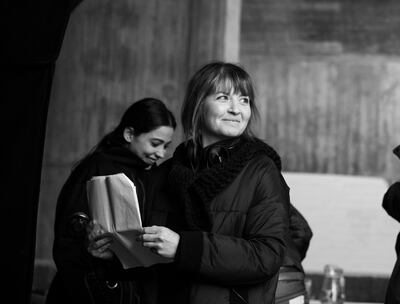Larissa Sansour's visions of a future Palestine are often not optimistic. The opening scene of her latest film, In Vitro, shows a river of oil spilling down Bethlehem's streets, destroying the historic Church of the Nativity. The ecological disaster razes the city.
Below this post-apocalyptic world is a bunker with an orchard of heirloom seeds saved by scientists who wish to replant them in the soil above. At the film's core is a dialogue on loss, memory and exile between two female scientists – Dunia, 70, the founder of the orchard, and her successor Alia, 30, who was born in the bunker. Monochromatic images from the film's production shoots and stills are on view until Thursday at Sansour's After exhibition at Dubai's Lawrie Shabibi gallery.
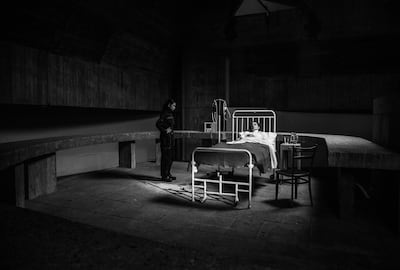
Like Sansour's more recent films, In Vitro – on view at the Danish Pavilion of the 58th Venice Biennale until Sunday, November 24 – is rooted in science fiction. But even though sci-fi has become a big part of the Palestinian artist's practice, she says she didn't grow up on it. "I wasn't a sci-fi buff. I've never watched a Star Wars film."
Instead, the choice was more a form of resistance. “It came out of a need of not documenting stuff from Palestine and defying expectations of a Middle Eastern artist and a woman … where I can speak about the Middle East or gender in a particular way.
I think we often associate science fiction with countries that we think of as progressive countries or the West and also very much male and white."
She’s right – think renowned filmmakers Stanley Kubrick, Ridley Scott, Steven Spielberg and James Cameron. “Using science fiction is already taking agency, trying to be part of that dialogue and trying to say, ‘I am also part of that vocabulary’,” she explains.
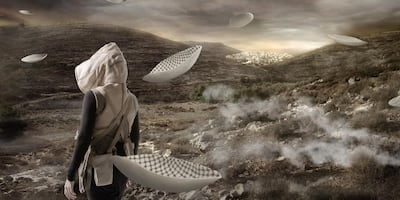
Sansour didn't always work with sci-fi. Her short documentary-style work from 2003, Tank, shows footage of peace activists blocking an Israeli tank as it makes its way through the occupied territories. Gradually, her videos imbued more fictional elements, and her foray into sci-fi was cemented with her 2009 Kubrickian A Space Exodus, an intergalactic commentary on displacement. In it, the first Palestinian astronaut in space, played by the artist, plants a Palestinian flag on the Moon to claim it for her country.
A Space Exodus was followed by two other films – Nation Estate (2012) and In The Future They Ate from the Finest Porcelain (2016) – that compose her sci-fi trilogy. For all of these projects, Sansour worked with her partner and artistic collaborator Soren Lind.
"Working with sci-fi is quite liberating because I work with difficult issues … I like to contextualise these dialogues in a framework that is not really expected," Sansour says.
The genre allows her to escape the contentious political jargon tied to the Palestine-Israel conflict, she says. "I can create my own world and my own vocabulary in which I can address the same issues."
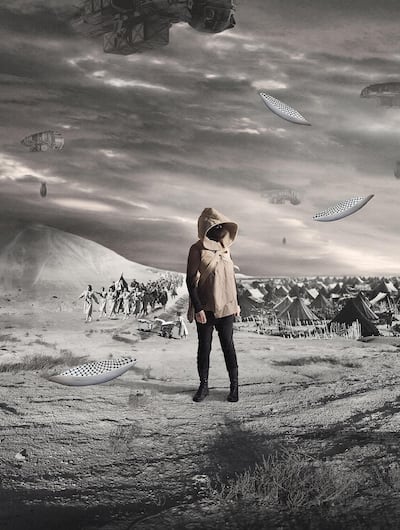
This can be seen in Nation Estate, in which the entirety of the Palestinian population and territories have been contained in a single skyscraper. Each floor houses a city – Ramallah, Nablus, Hebron, Gaza, Jerusalem, to name a few. On the surface, the development appears slick, modern and even convenient. But from a distance we see that it is still surrounded by the Israeli wall.
Residents have a view of the Dome of the Rock shrine from their windows, a scene that mirrors real life. "It's quite emotional for Palestinians that they can actually see the real house that they were kicked out of … but a lot of Palestinians are being exiled within Palestine itself," Sansour says. "They can see their house in Jerusalem, but they live outside in a refugee camp."
Sansour speaks from personal experience. She visits Bethlehem, where she has family, once a year. While there, her movements are often restricted and she has noticed the spread of settlements in the city and beyond. "There are parts where you actually can see the whole city surrounded. It feels like a complete prison, like you're being suffocated," she says.
Despite its futuristic, extra-terrestrial or dystopian elements, sci-fi is never truly distant from our world and time. In the same way, Sansour’s films are hardly removed from ongoing Palestinian concerns. “It’s quite important for me to discuss the Palestinian identity because it’s an identity that’s in trauma,” she says.
In Vitro, for example, explores a condition faced by those in the diaspora. "I was raised on nostalgia. The past spoon-fed to me. My own memories replaced by those of others," Alia says in the film. Though she didn't live through the eco-disaster she portrays, she still bears the trauma of those that came before her. "The pain these stories cause are two-fold because the loss I feel was never mine."
She challenges Dunia’s intentions to preserve history by passing down such memories to the next generation, resulting in a clouded present that is suspended between past and future. “I despise the idea of the present as nothing but a void. A transition between what was and what’s to come,” says Alia.
For her, the veneration of the past is merely a "liturgy chronicling our losses", reducing history to "symbols and iconography". The older Dunia responds that these stories are vital to survival. "Entire nations are built on fairy tales," she says.
Sansour takes no sides here. Instead, she asks what constitutes national identity and what happens when trauma transforms it. "Palestinian identity is linked to resistance and projecting for a future and for a Palestinian state … once that's gone, it's hard to understand what Palestinian identity becomes," she says.
The idea of mythmaking takes on another shape in the last film of Sansour's sci-fi trilogy, In the Future They Ate from the Finest Porcelain. A "narrative resistance" heroine buries keffiyeh-patterned plates underground with the aim of fabricating historical connections for future archaeologists to "uncover". The film was called anti-Semitic by a Jewish community organisation in the UK, though Sansour responded that it more broadly deals with the malleability of history and a question that arises after conflicts: who gets to tell the story and what will they say?
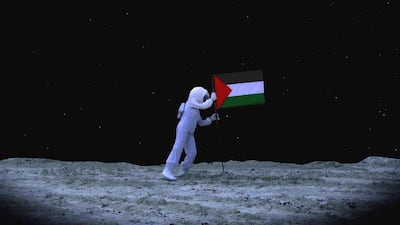
Sansour's projects continue to evolve. The artist points out that humour plays less of a role in her later works. A Space Exodus, for example, still had a sense of playfulness, while In Vitro is more ruminative. It also introduces a new theme, the problem of climate change, which the artist says is urgent. She says she is now working on a feature film and her next commission will stay in the realm of science fiction – a sci-fi opera on genetics that will be screened in Liverpool and Toronto next year.
Larissa Sansour’s After exhibition is at Lawrie Shabibi, Dubai, until Thursday, November 7.
